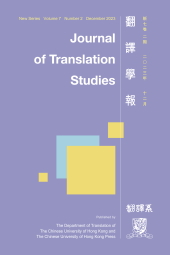 |
|
||||||||||||||||||||||||||||||||||||||||||||||||||||||||||||||||||||||||||||||||||||||||||
| Imagining the State: Translated Sovereignty in the First Chinese Translation of a Biography of Washington |
|---|
| Genzhong He University of Otago New Zealand |
|
Abstract In 1886, Li Ruqian 黎汝謙 (1852–1909) and Cai Guozhao 蔡國昭 (dates unknown) translated Washington Irving’s renowned biography of George Washington (1732–1799), which appeared under the title Huashengdun quanzhuan 華盛頓全傳 (A Complete Biography of Washington). It was the first Chinese translation of a biography about George Washington. The translation proved to be a valuable source of information for Chinese readers in the nineteenth century, as it covered the American Revolutionary War and the founding of the Republic, providing insights into American history and politics. Through the Li and Cai translation, this paper aims to explore how Chinese intellectuals understood and imagined the nature of a modern state during the late nineteenth century. The analysis will be contextualized through a discussion of sovereignty in the history of the interaction between China and Euro-American countries. As Qing China’s foreign relations differed from the Westphalian system of sovereignty featured by the Western “family of nations,” the concept of sovereignty was understood inconsistently. In their interpretation of Western forms of sovereignty, the Chinese translators employed terms such as zizhu 自主 (self-governance), junzhu 君主 (absolute monarchy), minzhu 民主 (republic), and yihui 議會 (parliament), echoing what Henry Wheaton (1785–1848) referred to as “external sovereignty” and “internal sovereignty.” This paper will analyze these terms to uncover changing Chinese perceptions of sovereignty and evaluate their impact on how Chinese intellectuals envisioned a modern state. The primary approach adopted in this analysis is back translation, which draws on Max Huang’s (2008) work and comparative close reading, enabling a nuanced examination of the differences and contingencies in the meanings of concepts between Western and Chinese contexts. Ultimately, this paper will contribute to our understanding of the political landscape as conceptualized by Chinese intellectuals before the peak of Japanese influence in the early twentieth century. |
| In Search of a Translation Policy for Hong Kong |
|---|
| Wai-on Law Independent Schola |
|
Abstract In a descriptive approach for a specific study, this article aims to explore the existing translation beliefs, management, and practices of Hong Kong. It first reviews the literature on translation policy and summarizes certain key concepts for application. In the focus case, it is found that the overt bilingual language policy of Hong Kong does not lead to any explicit translation policy. In some other official statements, translation management and practices are mentioned. It carries out institutional bilingualism with bilingual mandatory translation at the official level. For the small percentage of ethnic minorities, mostly South Asians, the government has set up guidelines to provide daily life assistance at departmental levels, including translation and interpretation. Certain non-governmental organizations are also involved. This is a typical case of a “cross-portfolio policy-making” approach to translation policy. The study recommends explicitation of the language and translation policies, along with their rationale, and the integration of the translation policies for minority languages. The Hong Kong case study could serve as a reference for policymakers and researchers, while the application of key concepts helps build the methodology for analyzing translation policies elsewhere. |
| Against Translation: An Inquiry into the Poetics of Opposition and Renewal |
|---|
| Kelly Washbourne Kent State University United States of America |
|
Abstract The taking of a critical stance toward particular translations has a long history in translation criticism, but the position against translation itself has been studied only piecemeal and without an eye to the commonalities and divergencies in the various stances that motivate it or to its divergent nomenclature. “Resistance to translation” is often evoked as a talisman of a text’s untranslatability (e.g., Apter 2013), but it can denote a translatorial opposition: refusing to translate or else translating subversively. The stance against translation may be born of various resistances: feminist, indigenist, postcolonial, or anthropological. To Robinson’s (1996) translation as taboo (owing to the ontological and theological status of the source), we can add aesthetic objections registered by those against translation. Non-translation, as a wholesale policy or a philosophy, is sometimes absolute. I briefly catalog some forms of anti-translation poetics: pseudotranslation, displacement, accentedness, untranslation, intradução, detranslation, counter-translation, distranslation, dystranslation, hypertranslation, mistranslation, transcreation, translelation, non-translation, partial translation and half-translation, literary machine translation, rhizomatic translation, and transtranslation. Critical linguistic-ideological stances and subversions of translation proper, these projects or platforms are meant to produce or champion everything from censure or opacity, to reinscription (“counter-translation”) or greater clarity of the source. |
| 重構「二戰」語境下的中國軍事譯員教育培訓 |
|---|
| 劉傑 中國 華中師範大學 中國香港 香港中文大學 |
|
摘 要 全面抗日戰爭時期的中國戰場是第二次世界大戰暨世界反法西斯戰爭中不可或缺的「東方主戰場」。抗戰時期由國民政府主導的軍事譯員訓練班是一項旨在配合援華盟軍對日作戰的創舉,亦是抗戰時期中國翻譯教育的一個縮影。1941 至1945年間國民政府軍委會在昆明和重慶等地通過徵調或招考,陸續培養了四千餘名英語譯員。他們大多是來自各高等院校的大學生或是英語較好的公職人員,通過兩至三個月不等的軍事英語和通譯業務培訓後,分配至中緬印戰區的美軍機關和戰爭前線任「翻譯官」,為抗戰勝利做出過不可磨滅的貢獻。本文以國民政府軍事譯員訓練班為研究對象,通過梳理戰時譯員教育的創辦與培養歷程,旨在回溯抗戰時期中國翻譯教育發展的歷史經緯,探析影響戰爭中語言教育的深層次社會文化因素,力求為譯學界重讀二十世紀中國翻譯教育史上的特殊一頁,提供一些可供鑒取的歷史經驗與文化哲思。 |
| Reconstructing Chinese Military Interpreter Training during the Second World War: A Cultural-Historical Perspective |
| Jie Liu Central China Normal University, China The Chinese University of Hong Kong, Hong Kong, China |
|
Abstract This article re-contextualizes the historical developments of Chinese military interpreter training during the Second World War. Through the study of the Kunming- and Chongqing-based interpreting officer training programs in the 1940s, the entire training scheme is divided into three phases. Discussions of each phase revolve around key strands of education, including enrollment, curriculum, training methods, and faculty composition. It is argued that, despite some deficiencies, the wartime training practices actually marked the first developmental phase in translation and interpreting training in China in the twentieth century. They comprised large-scale curriculum-based institutional training practices, which, as a feature of twentieth-century Chinese translation history and education, merit further research. The program structure and curriculum design discussed in the article are of relevance to translation and interpreting education today, thus contributing to the understanding of interpreter/translator training and interpreting/translating during the second Sino-Japanese war. |



